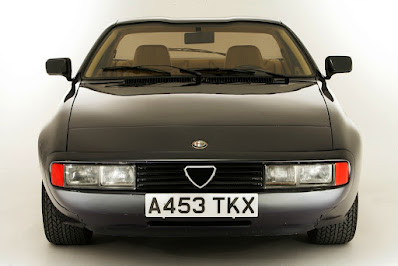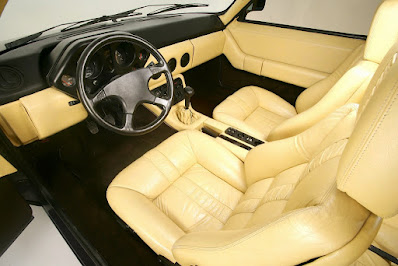Forgotten Wedge-Styled Car - In the late 1960s, a bold new trend emerged in the automotive world with the introduction of wedge-shaped car designs. These designs, marked by sharp angles, streamlined silhouettes, and futuristic aesthetics, represented a shift in the way cars looked and performed. The wedge shape wasn’t just a style choice; it symbolized speed, innovation, and a forward-thinking mindset that captured the imagination of designers and car enthusiasts alike. This daring approach to car design led to the creation of some iconic models, each showcasing unique interpretations of the wedge form.
 |
| The Alfa Romeo Zeta 6 by Zagato was a sleek two-seater coupe designed by Giuseppe Mittino, Zagato’s chief designer, known as the AZ6 Sperimentale. (Picture from: Carrozzieri-Italiani) |
The 1968 Alfa Romeo Carabo, 1969 Holden Hurricane RD001, 1970 Ferrari PF Modulo, and 1970 Lancia Stratos Zero were among the first to make an impact. These early models were revolutionary, with designs that appeared as though they belonged in science fiction rather than on modern highways. Each of these cars had distinctive elements, such as the Carabo’s scissor doors or the Stratos Zero’s ultra-low profile, which pushed boundaries and inspired a new generation of designers. Moving into the early 1970s, cars like the 1971 Lamborghini Countach, 1972 Maserati Boomerang, 1972 BMW Turbo E25, 1972 Lotus Esprit M70, and 1978 Dome Zero expanded on this wedge theme, emphasizing aerodynamics and performance.
 |
| The Alfa Romeo Zeta 6 by Zagato featured aluminum bodywork built on the chassis of the Alfa Romeo GTV6. (Picture from: Carrozzieri-Italiani) |
However, this era wasn’t solely dominated by widely recognized brands or models. Behind the scenes, brands like Alfa Romeo and renowned coachbuilders were also experimenting with their own interpretations of the wedge shape. Alfa Romeo, known for its high-performance, sporty cars, occasionally faced challenges in maintaining its focus on sports cars due to shifting priorities within the company and the Fiat group.
 |
| The Alfa Romeo Zeta Sei by Zagato featured with Zagato's distinctive “double bubble” roof design. (Picture from: Carrozzieri-Italiani) |
But fans and independent coachbuilders wanted to keep the brand's sporting heritage alive. This passion for Alfa Romeo’s racing DNA led to the appearance of unique, wedge-shaped Alfa models, such as the Alfa Romeo Zeta 6 (Sei) by Zagato, a car that remains largely unknown outside dedicated car enthusiast circles.
 |
| The Alfa Romeo Zeta 6 by Zagato was powered by a robust 2.5-liter V6 engine, providing it with impressive performance and a thrilling driving experience. (Picture from: Carrozzieri-Italiani) |
The Zeta 6 story began with a 1979 proposal by Giuseppe Mittino, Zagato’s chief designer. He approached Alfa Romeo with sketches of a sleek two-seater coupe that he called the AZ6 Sperimentale. Alfa Romeo, intrigued by the design, approved the production of two prototypes while also commissioning Bertone to create a counter-design, which became the Bertone Delfino. The Delfino, presented alongside the Zeta 6 at the 1983 Geneva Motor Show, was an angular, wedge-inspired concept that visually anticipated the Subaru SVX.
 |
| The Alfa Romeo Zeta 6 by Zagato featured typical short overhangs and echoed elements of the Porsche 928, showcasing a flowing window line that provided it with an unmistakable presence. (Picture from: Carrozzieri-Italiani) |
Yet, it was clear that the Zeta 6 was intended to be something more. Zagato took the Alfa Romeo GTV6 as the basis for the Zeta 6, outfitting it with a 2.5-liter V6 engine and a striking body that incorporated Zagato’s signature “double bubble” roof design. The Zeta 6 featured innovative details like rotating round door handles reminiscent of vintage telephone dials and a rear seating area that made it a 2+2 coupe, balancing style with a touch of practicality. The silhouette of the Zeta 6 also evoked elements of the Porsche 928, with a flowing window line that gave it an unmistakable presence.
 |
| The Alfa Romeo Zeta 6 by Zagato is complemented by a compact cockpit featuring an elegant 2+2 seat configuration. (Picture from: Carrozzieri-Italiani) |
 |
| One of the two Alfa Romeo Zeta 6 models found its way into a private collection in London and was later acquired by Italian collector Corrado Lopresto. (Picture from: Carrozzieri-Italiani) |
 The Zeta 6, like the iconic wedge-shaped models that came before it, represents a piece of automotive history characterized by daring design and innovative thinking. From the Alfa Romeo Carabo to the Maserati Boomerang, each of these models contributed to an era when car design was as much about expression and vision as it was about engineering. The Zeta 6 stands as a tribute to Alfa Romeo’s spirit of performance and Zagato’s legacy of bespoke craftsmanship. Even today, it continues to captivate collectors and enthusiasts, embodying an era that celebrated creativity, individuality, and the endless pursuit of speed and style. *** [EKA | FROM VARIOUS SOURCES | SECRET-CLASSIC | BELOWTHERADAR | CARROZZIERI-ITALIANI | CARDESIGNNEWS | JALPONIK ]
The Zeta 6, like the iconic wedge-shaped models that came before it, represents a piece of automotive history characterized by daring design and innovative thinking. From the Alfa Romeo Carabo to the Maserati Boomerang, each of these models contributed to an era when car design was as much about expression and vision as it was about engineering. The Zeta 6 stands as a tribute to Alfa Romeo’s spirit of performance and Zagato’s legacy of bespoke craftsmanship. Even today, it continues to captivate collectors and enthusiasts, embodying an era that celebrated creativity, individuality, and the endless pursuit of speed and style. *** [EKA | FROM VARIOUS SOURCES | SECRET-CLASSIC | BELOWTHERADAR | CARROZZIERI-ITALIANI | CARDESIGNNEWS | JALPONIK ]Note: This blog can be accessed via your smart phone
































